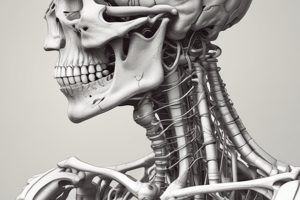Podcast
Questions and Answers
What describes the origin of a muscle?
What describes the origin of a muscle?
- It is the point of attachment that's immobile. (correct)
- It describes the angle between the origin and insertion.
- It refers to muscle contractions.
- It is the point of attachment that moves.
Which movement increases the angle between the origin and the insertion?
Which movement increases the angle between the origin and the insertion?
- Extension (correct)
- Adduction
- Flexion
- Abduction
What is the term for the lateral movement of the feet outward?
What is the term for the lateral movement of the feet outward?
- Eversion (correct)
- Dorsiflexion
- Inversion
- Plantar flexion
Which joint disorder involves the excessive stretching or tearing away of ligaments?
Which joint disorder involves the excessive stretching or tearing away of ligaments?
What defines circumduction in joint movement?
What defines circumduction in joint movement?
What is the primary function of articulations in the human body?
What is the primary function of articulations in the human body?
Which type of joint is primarily immovable?
Which type of joint is primarily immovable?
What type of joint is a gomphosis classified as?
What type of joint is a gomphosis classified as?
Which feature is NOT characteristic of synovial joints?
Which feature is NOT characteristic of synovial joints?
Which type of cartilage is found in synchondroses?
Which type of cartilage is found in synchondroses?
What type of joint is exemplified by the elbow?
What type of joint is exemplified by the elbow?
Which classification of joints allows for the greatest range of motion?
Which classification of joints allows for the greatest range of motion?
Which joint is considered a saddle joint?
Which joint is considered a saddle joint?
Flashcards are hidden until you start studying
Study Notes
Articulations
- An articulation is a joint, allowing for flexibility and holding bones together.
- Fibrous, Cartilaginous, and Synovial - These are the structural classifications of joints.
- Synarthroses, Amphiarthroses, and Diarthroses - These are the functional classifications of joints.
Fibrous Joints
- Held together by fibrous tissue, most are synarthrotic (immovable).
- Sutures are joints where bones interlock with short fibers, found in the skull.
- Syndesmoses are joints with bones connected by short ligaments, slightly movable, such as the tibia and fibula at the distal joint.
- A Gomphosis is the joint holding teeth in the mandible, using the periodontal ligament.
Cartilaginous Joints
- Articulating bones are connected by cartilage, have no joint cavity, mostly amphiarthrotic (slightly movable).
- Symphyses contain bones connected by a flat disc of fibrocartilage (ex. pubic symphysis).
- Synchondroses are bones connected by hyaline cartilage (ex. epiphyseal plates in children).
Synovial Joints
- Bones are separated by a joint cavity filled with synovial fluid, diarthrotic (freely movable).
- Characteristics of synovial joints:
- Articular Capsule: Two layers, a fibrous capsule and a synovial membrane that secretes synovial fluid.
- Articular cartilage: Hyaline cartilage covers the articulating bone surfaces.
- Ligaments: Hold bones of the joint together.
- Bursae: Fluid-filled sacs.
- Articular discs (ex. meniscus) can be present, acting as padding.
Synovial Joint Types
- Plane or gliding: (ex. intercarpal joints).
- Hinge: (ex. elbow).
- Pivot: (ex. atlas/axis).
- Condyloid: (ex. metacarpalphalangeal joints).
- Saddle: (ex. metacarpal/carpal).
- Ball and socket: (ex. shoulder or hip).
Muscle Attachment and Movement
- Origin: The point of muscle attachment that is immobile.
- Insertion: The point of muscle attachment that moves.
- Contraction: The insertion moves towards the origin.
Synovial Joint Body Movements
- Flexion: Decreases the angle between the origin and the insertion.
- Extension: Increases the angle between the origin and the insertion.
- Abduction: Movement away from the midline.
- Adduction: Movement towards the midline.
- Rotation: Movement around the long axis of a bone.
- Circumduction: Movement that makes an imaginary cone along the long axis of a bone.
- Pronation: Turning the hand from the anatomical position, crossing the ulna and radius.
- Supination: Returning the hand to the anatomical position, radius and ulna parallel.
Foot Movements
- Inversion: Turning the feet medially (inward).
- Eversion: Lateral movement of the feet (outward).
- Dorsiflexion: Movement of the feet upward.
- Plantar flexion: Movement of the toes downward.
Joint Disorders
- Sprain: Excessive stretching or tearing of ligaments.
- Dislocation: Forceful removal of bones from their normal position.
- Adhesion: Connecting of bones at their surfaces by fibrous bands.
- Spur: Extraneous growth of bone tissue.
Studying That Suits You
Use AI to generate personalized quizzes and flashcards to suit your learning preferences.




